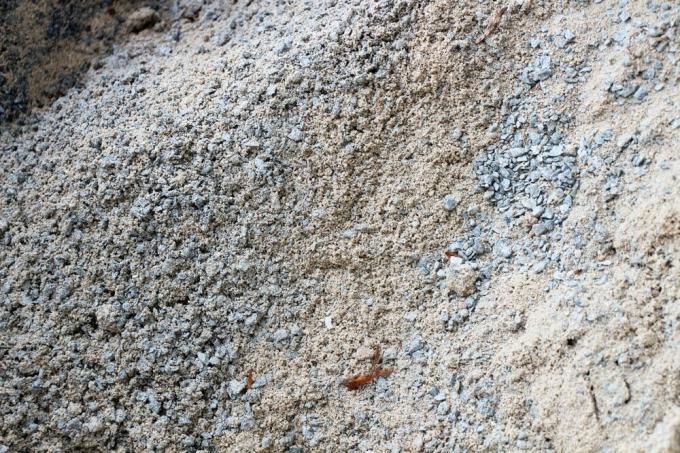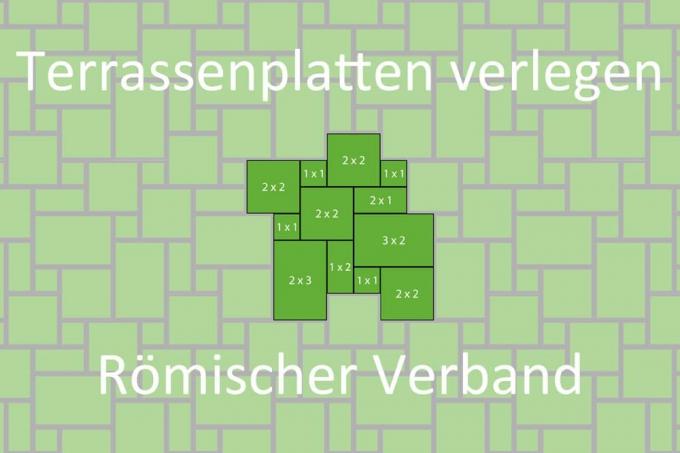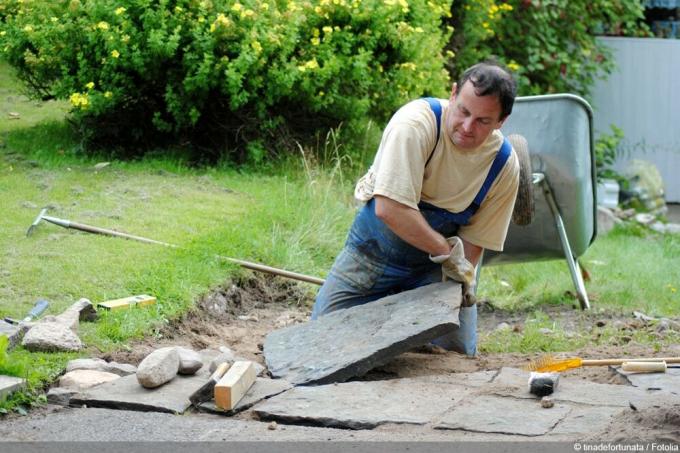

Table of contents
- grit
- sand
- Earth
- Lay patio tiles
- Roman Association
- half bandage
- Border terrace slabs
- Tips for buying patio tiles
- format of the plates
- Check plates
Barbecuing, chilling out, children playing, visiting friends and relatives, a patio has to endure a lot over the course of its life. It is therefore important that not only the right terrace tiles are selected, but also the right material on which the tiles are placed. After all, the terrace slabs should not sag afterwards. This is not only annoying, but also poses a risk of injury to people and pets. If you don't want to lay your slabs with mortar, you have three alternatives to choose from: earth, sand or grit.
grit
When laying on grit or Gravel, you should pay attention to the size of the gravel stones. A grain size of 2/5mm, 0/8mm or 5/8mm is recommended. To create the split bed, follow the instructions below:
- leadership or Set pull-off rails
- additionally tighten masonry cord
- Pour chippings onto surface
- along the guide rail
- Use a spirit level or a long straightening plate
- Height of the chippings bed: 30 to 50 mm
- Gradient to the lawn (rainwater drainage): 2 to 3 percent (spirit level)
Once all the preparatory work has been completed, you can start laying the terrace tiles.
sand

Building a terrace on sand is not recommended, as sand alone is too fine as a supporting layer. Therefore, when laying on sand, a supporting layer must be laid in preparation. Proceed as follows:
- create a load-bearing layer with a height of 20 centimeters
- Use crushed stone, grit or coarse-grained gravel
- lay a laying layer on top with a height of 5 centimeters
- use finer grit
- condense
- Put sand on top of the grit as the top layer
Earth
Loose soil is not suitable for laying terrace slabs. Because there is a risk that the panels will sag later. Compacting the soil reduces the risk, but you should not open the slabs the compacted soil, but on another supporting layer, such as gravel or Sand.
Lay patio tiles

Terrace slabs are made of many different materials, but there are still a few similarities when laying the slabs. So when you buy the terrace slabs, you should think about the format in which they should be laid on the terrace. For example, you can choose from the following formats:
Roman Association
This laying format consists of four to six panels of different sizes in the basic format, which is then repeated. The soil appears varied, but not restless. The format is ideal if the patio floor is to have a Mediterranean flair. However, it should be laid according to a laying plan.
half bandage
The semi-lattice becomes modern and straightforward. When laying, the panels in a row are offset by half their length. This gives the floor a slight "movement", but it remains tidy.
Tip:
Variants of this format are thirds, quarters and the so-called wild association.
Depending on which pattern or Format you have decided, start laying. That's the way to start
- in the middle
- at the house wall
- on the curbs
lay. To lay the tiles yourself, you need a rubber hammer next to the slabs, with which you can tap the laid stone. If the terrace slabs are laid seamlessly, then you should make sure that they are not clamped too tightly, because the slabs definitely need some movement. If laying with joints, then the joint crosses serve as spacers for even laying.
Border terrace slabs
To prevent the bed from sagging or individual terrace slabs from tipping over at the edge, it is advisable to border the terrace with suitable edging stones. If you don't like a border, you can also surround your terrace with an "invisible" border. The following options are available here:
- mortar wedge
- Lay the outermost row in a drainage mortar
- Stainless steel or plastic profiles on the panel edge
Once the lawn has grown, the edging is no longer visible and you have a seamless transition from the terrace to the lawn.
Tips for buying patio tiles

Terrace slabs are available on various materials, from almost raw natural stone to refined and polished stones to terrace slabs made of concrete, wood and plastic.
format of the plates
The format of the slabs on your terrace is, of course, entirely up to you. However, there are a few tips that can help you choose. With large slabs, for example, these come into their own more because there are fewer joints. Smaller formats have more joints, but the individual panels are often cheaper.
Check plates
If you have received your terrace slabs, you should check them to see whether
- the format supplied is correct
- the delivery is complete
- the plates are damaged
It is important that you check the tiles before laying them, because complaints are usually no longer possible after they have been laid. It is also annoying when the terrace floor cannot be finished because a slab is damaged.
Tip:
If you notice color differences in the patio tiles, this is normal with tiles made from natural materials. Therefore, to even out the slight differences, you should always use panels from different delivery crates for a row.
 garden editorial
garden editorial I write about everything that interests me in my garden.
Find out more about terraces and balconies

Sun protection for windy balconies and terraces
Sun protection turns the balcony and terrace into a cool oasis of well-being on hot days. However, if the cozy "outside" is windy, the question arises as to which shade provider will remain intact even in stronger winds.

Balcony privacy screen: 11 privacy screen ideas for the balcony
There are numerous ways to equip your own balcony with a privacy screen. Ideas that are easy to install and can be made of a wide variety of materials are used. Depending on the purpose, they can be used for the front of the balcony or as a side screen.

Laying tiles on the balcony: 6 options
A tile covering makes balconies durable, resilient and, last but not least, easy to clean. But only if you lay the coverings correctly is the success of a lasting nature. Therefore, you should know the common methods before you take action.

artificial grass | Costs, advantages & disadvantages
Artificial grass for the garden can be a wonderful alternative to real grass. However, it also has disadvantages. It should therefore be carefully weighed up whether the advantages or the potential problems outweigh the disadvantages in the individual case. We offer appropriate decision-making aids here.

Lay Bankirai | 7 tips for care and installation
The tropical wood Bankirai has long since become the standard in our homes and gardens. It is mainly used as a floor covering for terraces and balconies. Here's what to look out for when buying, how to lay and care for it correctly.

Cutting and laying the lawn carpet: Instructions in 6 steps
A lawn carpet offers many advantages and options for laying. Whether on the roof terrace, the balcony or in the garden, with artificial turf nobody has to do without ornamental grass. In addition to being easy to care for, you can also easily lay it yourself with the professional expert instructions.



